Liyiming Ke
$π_{0.5}$: a Vision-Language-Action Model with Open-World Generalization
Apr 22, 2025



Abstract:In order for robots to be useful, they must perform practically relevant tasks in the real world, outside of the lab. While vision-language-action (VLA) models have demonstrated impressive results for end-to-end robot control, it remains an open question how far such models can generalize in the wild. We describe $\pi_{0.5}$, a new model based on $\pi_{0}$ that uses co-training on heterogeneous tasks to enable broad generalization. $\pi_{0.5}$\ uses data from multiple robots, high-level semantic prediction, web data, and other sources to enable broadly generalizable real-world robotic manipulation. Our system uses a combination of co-training and hybrid multi-modal examples that combine image observations, language commands, object detections, semantic subtask prediction, and low-level actions. Our experiments show that this kind of knowledge transfer is essential for effective generalization, and we demonstrate for the first time that an end-to-end learning-enabled robotic system can perform long-horizon and dexterous manipulation skills, such as cleaning a kitchen or bedroom, in entirely new homes.
Hi Robot: Open-Ended Instruction Following with Hierarchical Vision-Language-Action Models
Feb 26, 2025Abstract:Generalist robots that can perform a range of different tasks in open-world settings must be able to not only reason about the steps needed to accomplish their goals, but also process complex instructions, prompts, and even feedback during task execution. Intricate instructions (e.g., "Could you make me a vegetarian sandwich?" or "I don't like that one") require not just the ability to physically perform the individual steps, but the ability to situate complex commands and feedback in the physical world. In this work, we describe a system that uses vision-language models in a hierarchical structure, first reasoning over complex prompts and user feedback to deduce the most appropriate next step to fulfill the task, and then performing that step with low-level actions. In contrast to direct instruction following methods that can fulfill simple commands ("pick up the cup"), our system can reason through complex prompts and incorporate situated feedback during task execution ("that's not trash"). We evaluate our system across three robotic platforms, including single-arm, dual-arm, and dual-arm mobile robots, demonstrating its ability to handle tasks such as cleaning messy tables, making sandwiches, and grocery shopping.
$π_0$: A Vision-Language-Action Flow Model for General Robot Control
Oct 31, 2024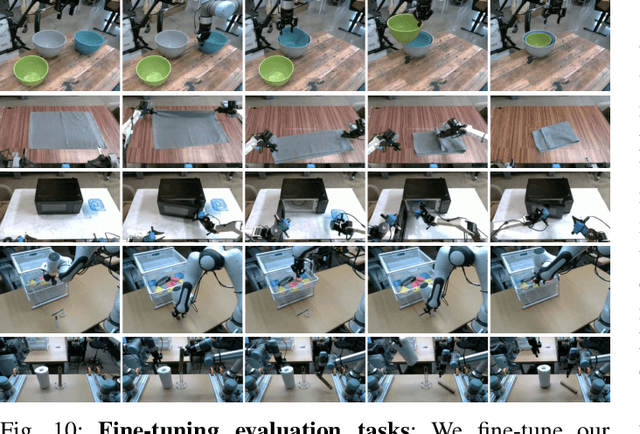
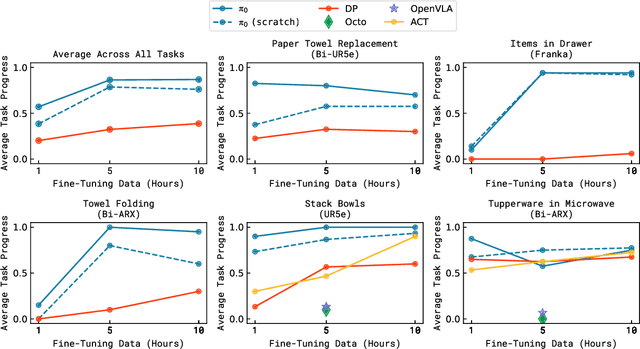
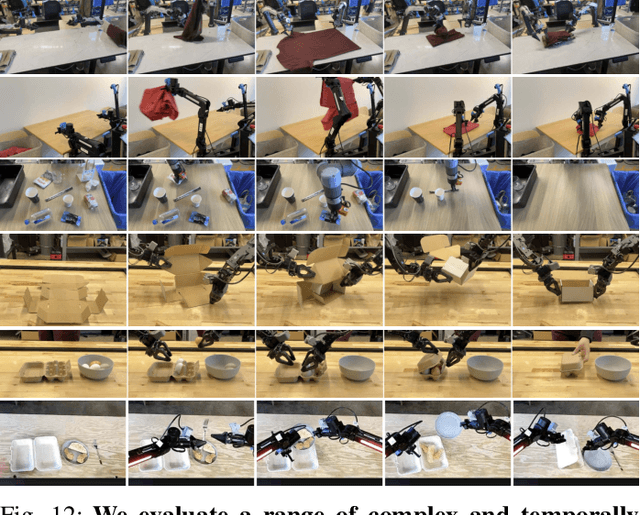
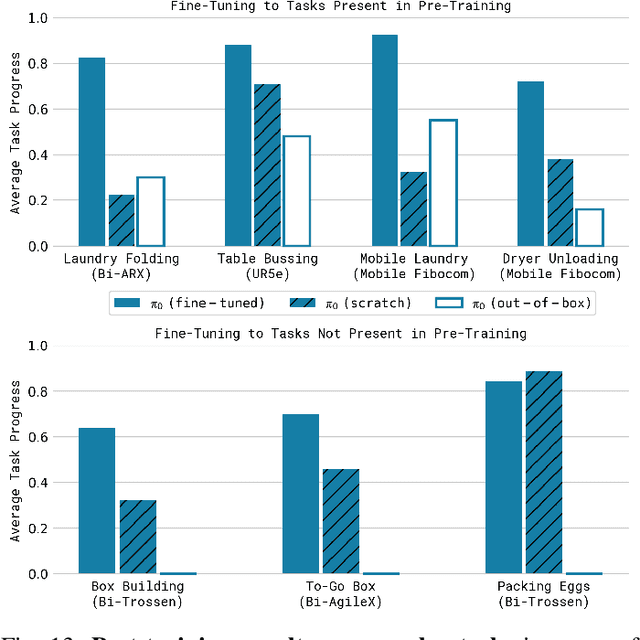
Abstract:Robot learning holds tremendous promise to unlock the full potential of flexible, general, and dexterous robot systems, as well as to address some of the deepest questions in artificial intelligence. However, bringing robot learning to the level of generality required for effective real-world systems faces major obstacles in terms of data, generalization, and robustness. In this paper, we discuss how generalist robot policies (i.e., robot foundation models) can address these challenges, and how we can design effective generalist robot policies for complex and highly dexterous tasks. We propose a novel flow matching architecture built on top of a pre-trained vision-language model (VLM) to inherit Internet-scale semantic knowledge. We then discuss how this model can be trained on a large and diverse dataset from multiple dexterous robot platforms, including single-arm robots, dual-arm robots, and mobile manipulators. We evaluate our model in terms of its ability to perform tasks in zero shot after pre-training, follow language instructions from people and from a high-level VLM policy, and its ability to acquire new skills via fine-tuning. Our results cover a wide variety of tasks, such as laundry folding, table cleaning, and assembling boxes.
Overcoming the Sim-to-Real Gap: Leveraging Simulation to Learn to Explore for Real-World RL
Oct 26, 2024



Abstract:In order to mitigate the sample complexity of real-world reinforcement learning, common practice is to first train a policy in a simulator where samples are cheap, and then deploy this policy in the real world, with the hope that it generalizes effectively. Such \emph{direct sim2real} transfer is not guaranteed to succeed, however, and in cases where it fails, it is unclear how to best utilize the simulator. In this work, we show that in many regimes, while direct sim2real transfer may fail, we can utilize the simulator to learn a set of \emph{exploratory} policies which enable efficient exploration in the real world. In particular, in the setting of low-rank MDPs, we show that coupling these exploratory policies with simple, practical approaches -- least-squares regression oracles and naive randomized exploration -- yields a polynomial sample complexity in the real world, an exponential improvement over direct sim2real transfer, or learning without access to a simulator. To the best of our knowledge, this is the first evidence that simulation transfer yields a provable gain in reinforcement learning in settings where direct sim2real transfer fails. We validate our theoretical results on several realistic robotic simulators and a real-world robotic sim2real task, demonstrating that transferring exploratory policies can yield substantial gains in practice as well.
Data Efficient Behavior Cloning for Fine Manipulation via Continuity-based Corrective Labels
May 29, 2024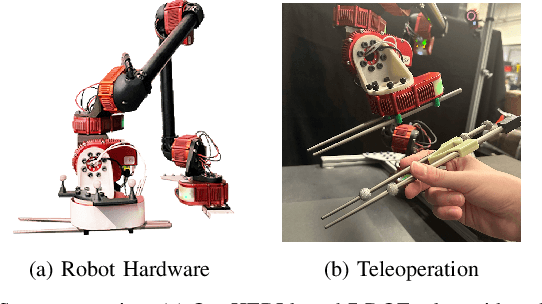


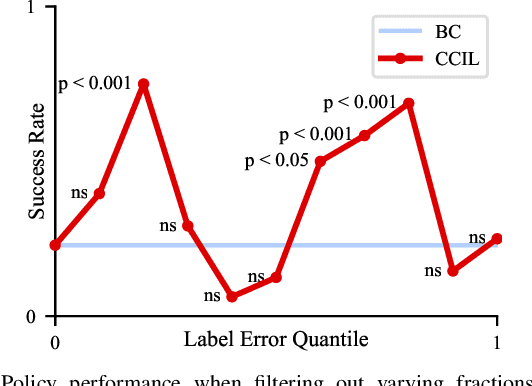
Abstract:We consider imitation learning with access only to expert demonstrations, whose real-world application is often limited by covariate shift due to compounding errors during execution. We investigate the effectiveness of the Continuity-based Corrective Labels for Imitation Learning (CCIL) framework in mitigating this issue for real-world fine manipulation tasks. CCIL generates corrective labels by learning a locally continuous dynamics model from demonstrations to guide the agent back toward expert states. Through extensive experiments on peg insertion and fine grasping, we provide the first empirical validation that CCIL can significantly improve imitation learning performance despite discontinuities present in contact-rich manipulation. We find that: (1) real-world manipulation exhibits sufficient local smoothness to apply CCIL, (2) generated corrective labels are most beneficial in low-data regimes, and (3) label filtering based on estimated dynamics model error enables performance gains. To effectively apply CCIL to robotic domains, we offer a practical instantiation of the framework and insights into design choices and hyperparameter selection. Our work demonstrates CCIL's practicality for alleviating compounding errors in imitation learning on physical robots.
CCIL: Continuity-based Data Augmentation for Corrective Imitation Learning
Oct 19, 2023



Abstract:We present a new technique to enhance the robustness of imitation learning methods by generating corrective data to account for compounding errors and disturbances. While existing methods rely on interactive expert labeling, additional offline datasets, or domain-specific invariances, our approach requires minimal additional assumptions beyond access to expert data. The key insight is to leverage local continuity in the environment dynamics to generate corrective labels. Our method first constructs a dynamics model from the expert demonstration, encouraging local Lipschitz continuity in the learned model. In locally continuous regions, this model allows us to generate corrective labels within the neighborhood of the demonstrations but beyond the actual set of states and actions in the dataset. Training on this augmented data enhances the agent's ability to recover from perturbations and deal with compounding errors. We demonstrate the effectiveness of our generated labels through experiments in a variety of robotics domains in simulation that have distinct forms of continuity and discontinuity, including classic control problems, drone flying, navigation with high-dimensional sensor observations, legged locomotion, and tabletop manipulation.
Cherry-Picking with Reinforcement Learning
Mar 09, 2023Abstract:Grasping small objects surrounded by unstable or non-rigid material plays a crucial role in applications such as surgery, harvesting, construction, disaster recovery, and assisted feeding. This task is especially difficult when fine manipulation is required in the presence of sensor noise and perception errors; this inevitably triggers dynamic motion, which is challenging to model precisely. Circumventing the difficulty to build accurate models for contacts and dynamics, data-driven methods like reinforcement learning (RL) can optimize task performance via trial and error. Applying these methods to real robots, however, has been hindered by factors such as prohibitively high sample complexity or the high training infrastructure cost for providing resets on hardware. This work presents CherryBot, an RL system that uses chopsticks for fine manipulation that surpasses human reactiveness for some dynamic grasping tasks. By carefully designing the training paradigm and algorithm, we study how to make a real-world robot learning system sample efficient and general while reducing the human effort required for supervision. Our system shows continual improvement through 30 minutes of real-world interaction: through reactive retry, it achieves an almost 100% success rate on the demanding task of using chopsticks to grasp small objects swinging in the air. We demonstrate the reactiveness, robustness and generalizability of CherryBot to varying object shapes and dynamics (e.g., external disturbances like wind and human perturbations). Videos are available at https://goodcherrybot.github.io/.
Real World Offline Reinforcement Learning with Realistic Data Source
Oct 12, 2022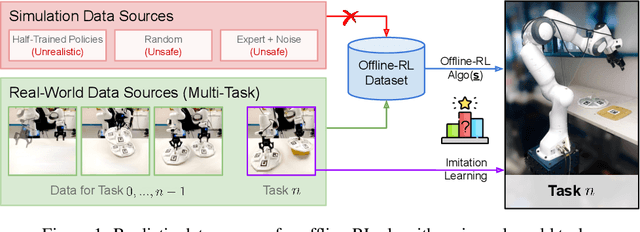



Abstract:Offline reinforcement learning (ORL) holds great promise for robot learning due to its ability to learn from arbitrary pre-generated experience. However, current ORL benchmarks are almost entirely in simulation and utilize contrived datasets like replay buffers of online RL agents or sub-optimal trajectories, and thus hold limited relevance for real-world robotics. In this work (Real-ORL), we posit that data collected from safe operations of closely related tasks are more practical data sources for real-world robot learning. Under these settings, we perform an extensive (6500+ trajectories collected over 800+ robot hours and 270+ human labor hour) empirical study evaluating generalization and transfer capabilities of representative ORL methods on four real-world tabletop manipulation tasks. Our study finds that ORL and imitation learning prefer different action spaces, and that ORL algorithms can generalize from leveraging offline heterogeneous data sources and outperform imitation learning. We release our dataset and implementations at URL: https://sites.google.com/view/real-orl
Grasping with Chopsticks: Combating Covariate Shift in Model-free Imitation Learning for Fine Manipulation
Nov 13, 2020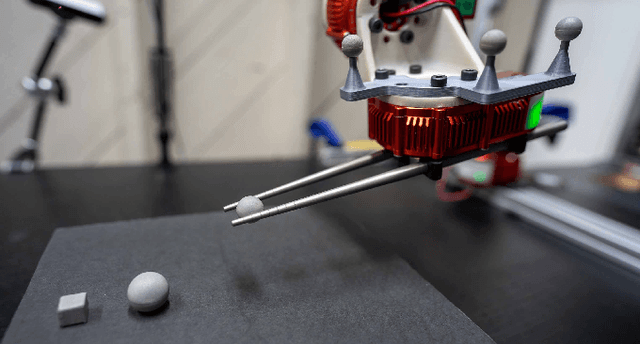



Abstract:Billions of people use chopsticks, a simple yet versatile tool, for fine manipulation of everyday objects. The small, curved, and slippery tips of chopsticks pose a challenge for picking up small objects, making them a suitably complex test case. This paper leverages human demonstrations to develop an autonomous chopsticks-equipped robotic manipulator. Due to the lack of accurate models for fine manipulation, we explore model-free imitation learning, which traditionally suffers from the covariate shift phenomenon that causes poor generalization. We propose two approaches to reduce covariate shift, neither of which requires access to an interactive expert or a model, unlike previous approaches. First, we alleviate single-step prediction errors by applying an invariant operator to increase the data support at critical steps for grasping. Second, we generate synthetic corrective labels by adding bounded noise and combining parametric and non-parametric methods to prevent error accumulation. We demonstrate our methods on a real chopstick-equipped robot that we built, and observe the agent's success rate increase from 37.3% to 80%, which is comparable to the human expert performance of 82.6%.
Telemanipulation with Chopsticks: Analyzing Human Factors in User Demonstrations
Jul 31, 2020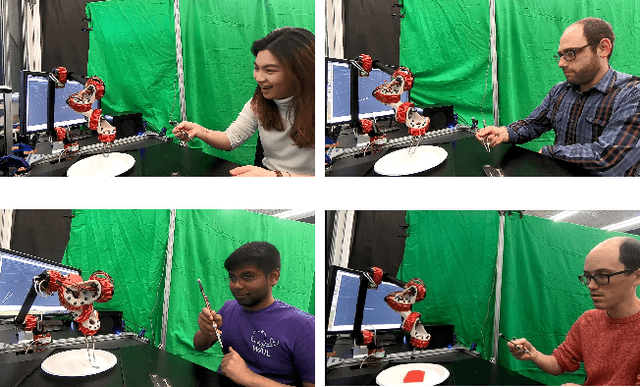


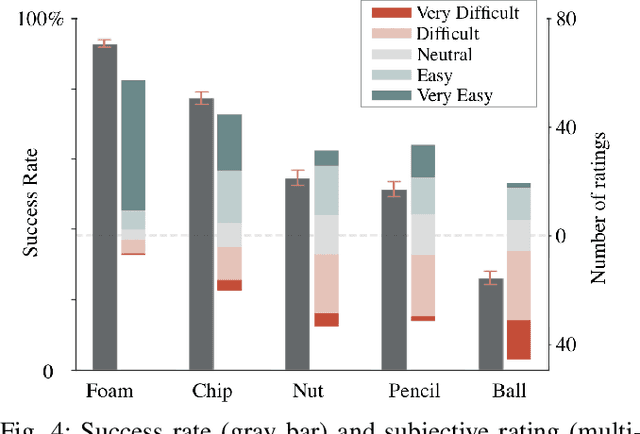
Abstract:Chopsticks constitute a simple yet versatile tool that humans have used for thousands of years to perform a variety of challenging tasks ranging from food manipulation to surgery. Applying such a simple tool in a diverse repertoire of scenarios requires significant adaptability. Towards developing autonomous manipulators with comparable adaptability to humans, we study chopsticks-based manipulation to gain insights into human manipulation strategies. We conduct a within-subjects user study with 25 participants, evaluating three different data-collection methods: normal chopsticks, motion-captured chopsticks, and a novel chopstick telemanipulation interface. We analyze factors governing human performance across a variety of challenging chopstick-based grasping tasks. Although participants rated teleoperation as the least comfortable and most difficult-to-use method, teleoperation enabled users to achieve the highest success rates on three out of five objects considered. Further, we notice that subjects quickly learned and adapted to the teleoperation interface. Finally, while motion-captured chopsticks could provide a better reflection of how humans use chopsticks, the teleoperation interface can produce quality on-hardware demonstrations from which the robot can directly learn.
 Add to Chrome
Add to Chrome Add to Firefox
Add to Firefox Add to Edge
Add to Edge